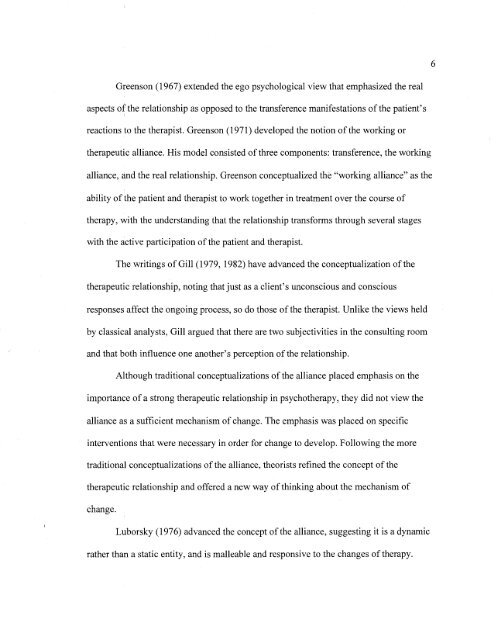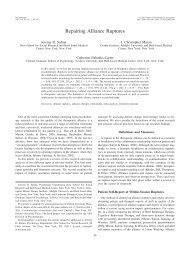Download - The Safran Lab
Download - The Safran Lab
Download - The Safran Lab
You also want an ePaper? Increase the reach of your titles
YUMPU automatically turns print PDFs into web optimized ePapers that Google loves.
Greenson (1967) extended the ego psychological view that emphasized the real<br />
aspects of the relationship as opposed to the transference manifestations of the patient's<br />
reactions to the therapist. Greenson (1971) developed the notion of the working or<br />
therapeutic alliance. His model consisted of three components: transference, the working<br />
alliance, and the real relationship. Greenson conceptualized the "working alliance" as the<br />
ability of the patient and therapist to work together in treatment over the course of<br />
therapy, with the understanding that the relationship transforms through several stages<br />
with the active participation of the patient and therapist.<br />
<strong>The</strong> writings of Gill (1979, 1982) have advanced the conceptualization of the<br />
therapeutic relationship, noting that just as a client's unconscious and conscious<br />
responses affect the ongoing process, so do those of the therapist. Unlike the views held<br />
by classical analysts, Gill argued that there are two subjectivities in the consulting room<br />
and that both influence one another's perception of the relationship.<br />
Although traditional conceptualizations of the alliance placed emphasis on the<br />
importance of a strong therapeutic relationship in psychotherapy, they did not view the<br />
alliance as a sufficient mechanism of change. <strong>The</strong> emphasis was placed on specific<br />
interventions that were necessary in order for change to develop. Following the more<br />
traditional conceptualizations of the alliance, theorists refined the concept of the<br />
therapeutic relationship and offered a new way of thinking about the mechanism of<br />
change.<br />
Luborsky (1976) advanced the concept of the alliance, suggesting it is a dynamic<br />
rather than a static entity, and is malleable and responsive to the changes of therapy.<br />
6



